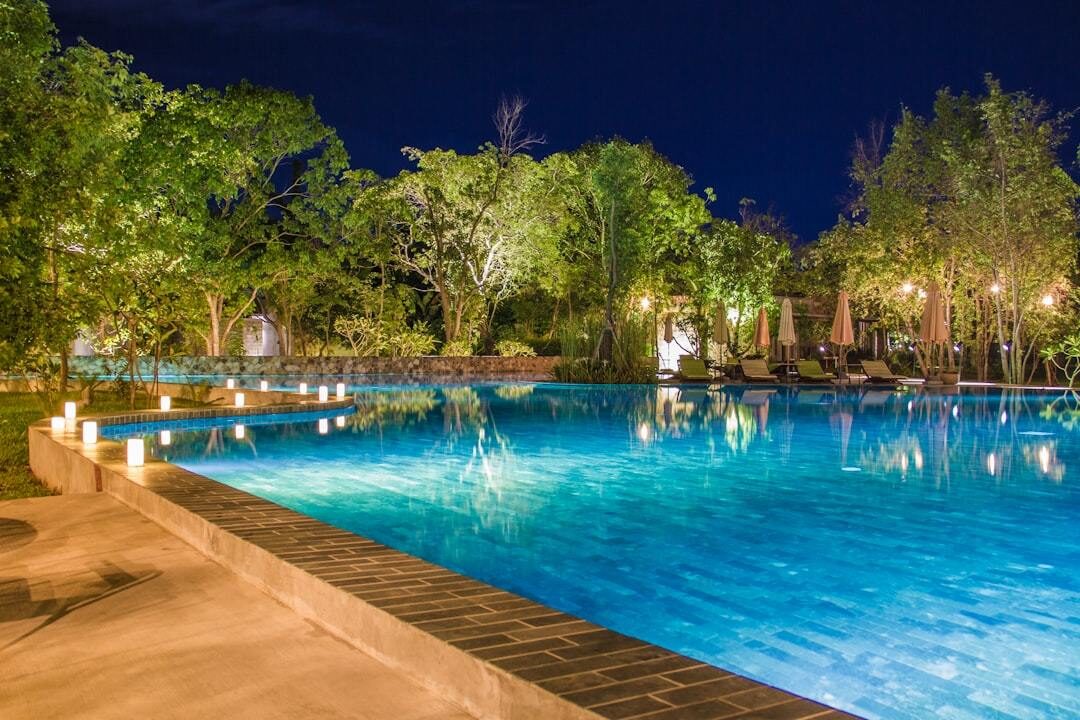Is your pool light acting up? It’s a common problem, but that doesn’t make it any less annoying. I remember when I first encountered a broken pool light – I was at a loss. But through trial and error, I figured out how to fix it, and now I want to share that knowledge with you. Get ready for a step-by-step guide that’ll have your pool light shining bright in no time! If you’re not comfortable get an electrician or a pool service company to help you out in the process of how to fix your swimming pool light.
Whether you’re dealing with a burned-out bulb, a faulty fixture, or some mysterious electrical issue, we’ll cover all the bases. Get ready to roll up your sleeves and dive into the world of pool light repair. Trust me, with a little know-how and some elbow grease, you’ll have your pool illuminated in no time.
Troubleshooting a Broken Pool Light
Is your pool light not working? Don’t worry, you’re not alone. Pool lights can stop functioning for a variety of reasons, but the good news is that troubleshooting the issue is often straightforward. In my experience, the first step is always to check the power source. Make sure the circuit breaker for the pool equipment hasn’t tripped and that the light switch is turned on. If everything looks good there, it’s time to take a closer look at the swimming pool light itself.
Check the Power Source
Before attempting any repairs on a broken pool light, it’s crucial to first check the power source. This involves ensuring the circuit breaker for the pool equipment is turned on and that there are no tripped GFCI outlets or switches. If the power source appears to be functioning properly, move on to inspecting the light fixture itself.
Inspect the Light Fixture
A thorough inspection of the pool light fixture can often reveal the cause of the problem. Check for any visible damage, such as cracks in the lens or housing, or signs of water infiltration. Ensure the fixture is securely attached to the pool wall and that the mating surface is clean and free of debris. If the fixture appears to be in good condition, the issue may lie with the light bulb.
Test the Light Bulb
If the power source and light fixture are functioning correctly, the problem likely stems from a faulty light bulb. Carefully remove the bulb from the fixture and examine it for any visible damage or burn marks. Use a multimeter to test the bulb’s continuity. If the bulb is determined to be defective, replace it with a new one that has the same wattage and voltage specifications.
Check for Loose Connections
Loose or corroded electrical connections can prevent a pool light from functioning properly. Inspect the junction box and the wiring leading to the light fixture for any signs of damage or loose connections. If necessary, tighten any loose terminal screws and replace any corroded wiring. Ensure all connections are secure and waterproof before reassembling the light fixture.
Step-by-Step Guide to Replacing a Pool Light
So, you’ve determined that your pool light needs to be replaced. Don’t stress – I’ve changed out my fair share of pool lights over the years, and I can tell you that it’s not as daunting as it might seem. The key is to take your time, follow the steps carefully, and always prioritize safety. Here’s a step-by-step guide to replacing a pool light based on my own experience:
Turn Off Power and Drain the Pool
Before beginning any work on the pool light, it is essential to turn off all power to the pool lighting at the circuit breaker. Double-check that the power is off by attempting to turn on the pool lights. To access the light fixture, the pool water level must be lowered below the light niche. Use a submersible pump to drain the pool to the appropriate level.
Remove the Light Fixture
With the power off and the pool drained, remove the single screw at the top of the light fixture to detach it from the pool wall. Carefully pull the fixture out of the niche and onto the pool deck. Take care not to damage the wiring or the mating surface of the light niche during this process.
Install the New Light Fixture
Before installing the new light fixture, ensure that the replacement bulb is identical to the original in terms of wattage and voltage. Use a towel to handle the bulb and avoid touching it with bare hands, as oils from the skin can cause premature failure. Secure the new bulb in the fixture and reassemble the housing, making sure the lens gasket is properly seated to prevent water intrusion. Carefully push the new light fixture back into the niche and secure it with the screw.
Restore Power and Refill the Pool
Once the new light fixture is installed, turn the power back on at the circuit breaker. Test the light to ensure it is functioning properly. If the light works as intended, begin refilling the pool to its normal operating level. Once the pool is refilled, test the light again to verify that it works underwater and that there are no signs of leaks around the fixture.
Tips for Maintaining Your Pool Lighting
Proper maintenance is key to extending the life of your pool lighting and preventing future issues. Trust me, a little bit of regular TLC can save you a lot of headaches (and money) down the line. Here are some tips I’ve learned over the years for keeping your pool lighting in tip-top shape:
Perform Regular Inspections
To prevent pool light issues and ensure the longevity of your lighting system, it’s important to perform regular inspections. Periodically check the light fixtures for any signs of damage, water intrusion, or loose connections. Addressing minor problems early on can help avoid more costly repairs down the line.
Use a Non-Contact Voltage Tester
When working with electrical components around the pool, safety should always be the top priority. Use a non-contact voltage tester to verify that the power is off before beginning any work on the light fixtures. This simple tool can help prevent electrical shock and ensure a safe working environment.
Watch for Warning Signs
Be attentive to warning signs that may indicate a problem with your pool lighting. Flickering lights, dimming, or a complete loss of function can all be indicators of an issue that needs to be addressed. Additionally, if you notice any bubbles coming from the light fixture or signs of water in the housing, it’s crucial to take immediate action to prevent further damage.
Know When to Seek Professional Help
While many pool light issues can be resolved with simple repairs or replacements, some problems may require the expertise of a professional. If you are unsure about how to proceed with a repair or if you suspect a more serious electrical issue, it’s best to contact a licensed electrician or pool professional. Attempting complex repairs without the proper knowledge and tools can be dangerous and may lead to further damage to your pool lighting system.
Fixing a pool light is often simple: check the power, inspect the fixture and bulb, tighten connections, or replace the light. Always turn off electricity first for safety. Regular maintenance can prevent future issues.
Conclusion
There you have it a crash course in fixing a swimming pool light. We’ve covered everything from troubleshooting common issues to replacing a faulty fixture and maintaining your pool lighting for the long haul.
Remember, regular inspections, a trusty voltage tester, and a keen eye for warning signs are your best friends when it comes to keeping your pool lights shining bright. And if you ever find yourself in over your head, don’t hesitate to call in the pros.
So, whether you’re a seasoned DIY enthusiast or a first-time pool owner, you now have the tools and knowledge to tackle this challenge head-on. Go forth and conquer, my friend your pool’s counting on you!








